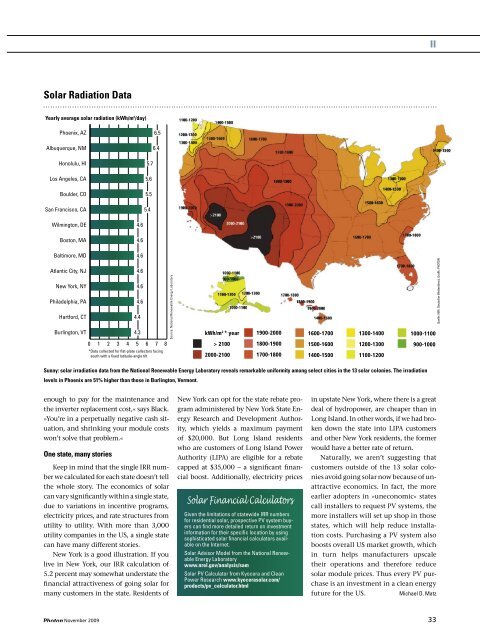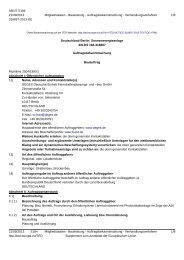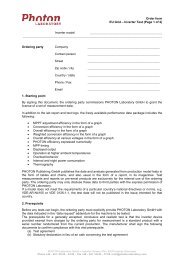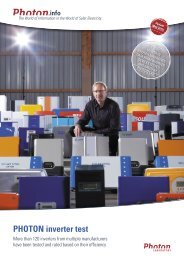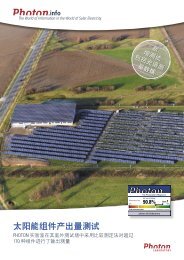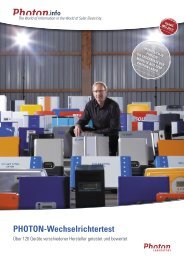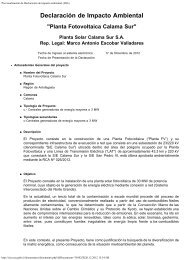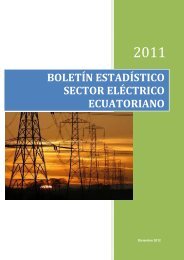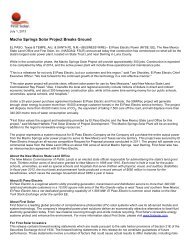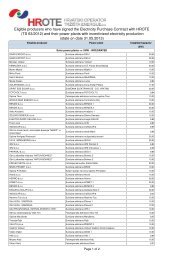INTRODUCTORY SPECIAL INTRODUCTORY ... - PHOTON Info
INTRODUCTORY SPECIAL INTRODUCTORY ... - PHOTON Info
INTRODUCTORY SPECIAL INTRODUCTORY ... - PHOTON Info
You also want an ePaper? Increase the reach of your titles
YUMPU automatically turns print PDFs into web optimized ePapers that Google loves.
Solar Radiation Data<br />
Yearly average solar radiation (kWh/m 2 /day)<br />
Phoenix, AZ<br />
Albuquerque, NM<br />
Honolulu, HI<br />
Los Angeles, CA<br />
Boulder, CO<br />
San Francisco, CA<br />
Wilmington, DE<br />
Boston, MA<br />
Baltimore, MD<br />
Atlantic City, NJ<br />
New York, NY<br />
Philadelphia, PA<br />
Hartford, CT<br />
Burlington, VT<br />
4.6<br />
4.6<br />
4.6<br />
4.6<br />
4.6<br />
4.6<br />
4.4<br />
4.3<br />
5.7<br />
5.6<br />
5.5<br />
5.4<br />
6.5<br />
6.4<br />
0 1 2 3 4 5 6 7 8<br />
*Data collected for flat-plate collectors facing<br />
south with a fixed latitude-angle tilt<br />
Sunny: solar irradiation data from the National Renewable Energy Laboratory reveals remarkable uniformity among select cities in the 13 solar colonies. The irradiation<br />
levels in Phoenix are 51% higher than those in Burlington, Vermont.<br />
enough to pay for the maintenance and<br />
the inverter replacement cost,« says Black.<br />
»You’re in a perpetually negative cash sit-<br />
uation, and shrinking your module costs<br />
won’t solve that problem.«<br />
One state, many stories<br />
Keep in mind that the single IRR num-<br />
ber we calculated for each state doesn’t tell<br />
the whole story. The economics of solar<br />
can vary significantly within a single state,<br />
due to variations in incentive programs,<br />
electricity prices, and rate structures from<br />
utility to utility. With more than 3,000<br />
utility companies in the US, a single state<br />
can have many different stories.<br />
New York is a good illustration. If you<br />
live in New York, our IRR calculation of<br />
5.2 percent may somewhat understate the<br />
financial attractiveness of going solar for<br />
many customers in the state. Residents of<br />
Source: National Renewable Energy Laboratory<br />
kWh/m 2 * year<br />
> 2100<br />
2000-2100<br />
1900-2000<br />
1800-1900<br />
1700-1800<br />
New York can opt for the state rebate pro-<br />
gram administered by New York State En-<br />
ergy Research and Development Author-<br />
ity, which yields a maximum payment<br />
of $20,000. But Long Island residents<br />
who are customers of Long Island Power<br />
Authority (LIPA) are eligible for a rebate<br />
capped at $35,000 – a significant finan-<br />
cial boost. Additionally, electricity prices<br />
Solar Financial Calculators<br />
Given the limitations of statewide IRR numbers<br />
for residential solar, prospective PV system buyers<br />
can find more detailed return on investment<br />
information for their specific location by using<br />
sophisticated solar financial calculators available<br />
on the Internet.<br />
Solar Advisor Model from the National Renewable<br />
Energy Laboratory<br />
www.nrel.gov/analysis/sam<br />
Solar PV Calculator from Kyocera and Clean<br />
Power Research www.kyocerasolar.com/<br />
products/pv_calculator.html<br />
1600-1700<br />
1500-1600<br />
1400-1500<br />
1300-1400<br />
1200-1300<br />
1100-1200<br />
November 2009 33<br />
ıı<br />
1000-1100<br />
900-1000<br />
in upstate New York, where there is a great<br />
deal of hydropower, are cheaper than in<br />
Long Island. In other words, if we had bro-<br />
ken down the state into LIPA customers<br />
and other New York residents, the former<br />
would have a better rate of return.<br />
Naturally, we aren’t suggesting that<br />
customers outside of the 13 solar colo-<br />
nies avoid going solar now because of un-<br />
attractive economics. In fact, the more<br />
earlier adopters in »uneconomic« states<br />
call installers to request PV systems, the<br />
more installers will set up shop in those<br />
states, which will help reduce installa-<br />
tion costs. Purchasing a PV system also<br />
boosts overall US market growth, which<br />
in turn helps manufacturers upscale<br />
their operations and therefore reduce<br />
solar module prices. Thus every PV pur-<br />
chase is an investment in a clean energy<br />
future for the US. Michael D. Matz<br />
Quelle: NRE: Deutscher Wetterdienst, Grafik: <strong>PHOTON</strong>


